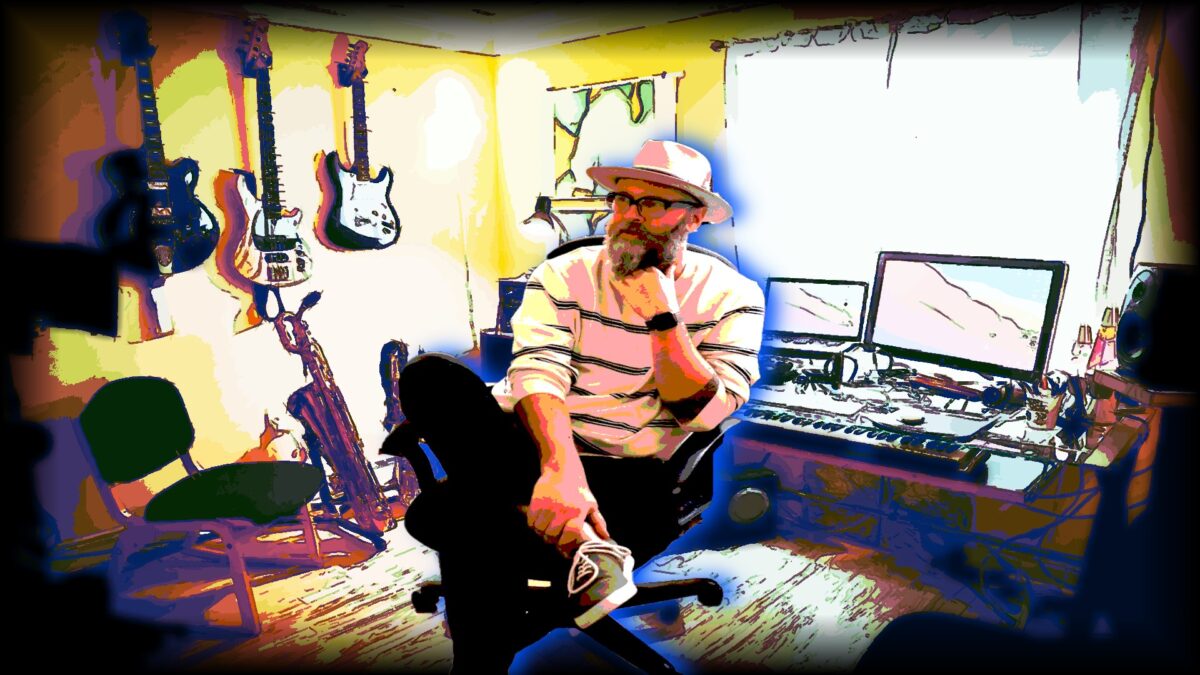Born in Lillihammer, Norway, Ole Oddlokken spent his winters as many children did in the area; outdoors, often skiing. During the summer months when the climate had warmed, you could find him participating in the local marching band. Unlike here, the marching bands there were, and still are, not directly affiliated with schools. But many children in Lillihammer volunteered and Ole would do the same. Originally, he took interest in the valve trombone, but this was a popular choice for many of the kids. So, the band leader suggested a saxophone. Sometimes it’s life that steers us in just the right direction. As this sax really resonated with ten-year-old Ole and is still his instrument of choice today. The first two songs he learned would be Frere Jaque and (ironically) When the Saints Go Marching In. Being an extra-curricular activity, a true desire was present amongst children in this program. They gave end of the year recitals and many would often go on to perform in the adult community orchestra. As an adult, Ole followed suit, performing with several orchestras and big bands in town. It was then that he was exposed to jazz music.
While playing in various bands, Ole studied fine art at a college in Olso, a town south of Lillihammer. There he would meet his future wife, Nonny, an exchange student originally from New Orleans, Louisiana. He and Nonny would go onto marry, eventually giving birth to a baby girl. In 1994, when their daughter was a year old, they moved to New Orleans and settled in as a family. His saxophone would rest in its case for the next eleven years, as life for Ole became less about the arts and more about family and a regular job. Hurricane Katrina spurred a desire for inspiration and creation in Ole. And luckily that saxophone survived the storm. Joining a small folk singer/ songwriter band quenched his thirst for the arts. They played shows around town and went on to put out an EP. But during this time, he had been doing photography work and there were concerns about making gigs and so forth. So, after a few years, Ole left the band. But moving forward, that sax wouldn’t see its case as often, as dipping his feet in musical waters was a path that once again reunited Ole with his passion. And, as he said, “from there, the rest is history”.
This long span of time that encompassed his move and settlement into the U.S. left Ole without any musicality. It also cleansed his palette of the music styles and compositions of his homeland. Starting again in music for him might as well have been starting anew, as his new surroundings brought new roles and atmospheres. He traded sheet music and traditional styles for improvisation. Although this had been new and exciting territory for Ole, a rift would again soon form between him and his calling. Putting down the sax to concentrate on his photography gig once again left a void within him. And after a year he found his way back into music through a Craigslist ad, joining a funk band by the name of Noisewater. The new digs were a fun change of pace; not particularly deep, but a hit in the bar/ venue scene. Local shows at Café Negril on Frenchmen Street, Banks Street Bar, Tipitina’s and others close to home made managing a job, a family, and band performances possible. And by all accounts, the band did well. They were on tv and radio, and even put out an EP. Delving further into expression and farther away from theory, Ole would occasionally get together and play with Will Vance and the Kinfolk, as well as improvisational funk, hip hop band, Breaux Jackson. Ole recalls a crazy night playing with Breaux Jackson at One Eye’d Jacks, where Andy Dick showed up. The night resulted in a viral video you might have seen where Andy Dick got knocked out just outside the venue.
Through a booking contact in Lake Charles, Noisewater had the chance to play a few dates with The Shizz, headed up by classically trained singer Lilly Lewis. As time went on, Noisewater would play fewer and fewer gigs, and Ole would go on to play in Lilly’s following band, The Lilly Lewis Project. Several of Noisewater’s members would do the same. Chad Carlisle would bring contributions on keys, and Will Laird would come in on bass. Although at times a bit funky, the Lilly Lewis Project is something special. Introspective thoughts project outward as she discusses things like losing one’s self, or what freedom means to her. And this was yet another change of pace for Ole. He had long ago left sheet music for exploratory improv and funk. And now, for the past six years, he has been able to contribute to a more soulful mixture in Lilly’s band.
Not that long ago, Ole went back to Norway for a visit with family. Just after his return he was able to play one show with the Lilly Lewis Project at the New Orleans Jazz and Heritage Foundation stage on Rampart. Then Covid hit, bringing live performances to a halt. But by this time, his love of the craft had cemented itself deep within him. Fortunately, his saxophone would not be relinquished to its case as in previous instances. Oddly enough, this deafening silence handed down to us all became yet another inspiration for him. And as he noted, he feels as though it made him a better sax player, among other things. He reacted by writing his own music and setting up a recording studio in his home office. “The label I worked for, put out this thing (on social media) just to get people to share music and such which was ‘tag five musicians and share a music video of you playing a song.’ So, I was like, ok I’ll join in on that. I had been writing some music so I recorded myself playing that and put that up. I continued writing music and making videos just to have some sort of creative outlet. Next thing you know, I was like, this looks like a full album at this point.” Ole would begin a journey that resulted in his first self-produced and recorded album, The Home Office Sessions.
Following the videos that inspired this, the project began with Ole writing and recording his parts. Once all of the parts were recorded, he began reaching out to former band mates to record their parts and add their style. Brandon Hotard and Hayden Winfried, both from Noisewater, contributed guitar work, as did guitarist and producer Britton Newton. Chad Carlisle, who we mentioned earlier from Noisewater, made contributions on keys. For drums, Ole tapped on Wayde Hymel of the Lilly Lewis Project, as well as Milton Mansfield, and James Clarke. To polish things off, he was able to procure a percussionist and a cellist from New England. Lyricist Da Prophecy came in for some features rapping and Nonny, his wife, did spoken word. Throughout the project, he encouraged the contributors to play what they felt, only occasionally requesting a swell here or a certain texture there.
On our website, neworleansmusicians.com, you will find a delightful new experience for Ole in the form a music video for one of the songs featured on The Home Office Sessions, Master Divider. The night we spoke of earlier where Andy Dick got knocked out at One Eye’d Jacks was when Ole first met lyrical contributor Da Prophecy. The two shared the stage that night, as Da Prophecy sat in on a few Breaux Jackson songs. This time, Da Prophecy contributed lyrics to Master Divider, a beautifully written jazz track with rap lyrics. Ole also made use of a website that generates visual pieces from which an artist can build a music video. The music video link, as well as a link to the video composition website will be included below. Diverging from his time with Noisewater and the bar-scene party hits, he wanted this album to say something. Though he does not doubt that his heritage and musical back ground may have snuck its way into this work, Ole feels as though being Norwegian didn’t really come out in his expressions on this album. In fact, one of the songs that didn’t make it to the album was a Norwegian folk standard. He felt as though it didn’t really fit. And honestly, he finds Norwegian music to be a bit melancholy, straying from the vibe of this album. At times, the guitar work gets a bit heavy in his opinion. As Ole explained, “instead of just being all melancholy and chill, I like the contrast of that guitar on a couple of songs where it gets heavy”. He did mention drawing inspiration from his love for a German label, ECM, whose catalog features euro jazz, classical, and rock albums. He also cited Christian Scott’s post-Katrina work, Anthem, as a source of inspiration.
As a body of work, The Home Office Sessions album spans genres and moods, definitely lending itself to crossover appeal. I believe there’s something in there for everyone. Though mostly an instrumental, the album enjoys lyrical guest appearances from both Da Prophecy and Ole’s wife Nonny. Being created solely as a response to an epidemic lockdown, this album effectively has not seen the light of day; sans the digital arena. Ole hopes to once again call on his musician friends and perform the album live. Exposing the album and getting in-person feedback will bring this project around full-circle. And it’s something we should all look out for. Until then you can find the video for Master Divider at the link below.
Author: David Trahan
Master Divider – https://neworleansmusicians.com/video/180
Master Divider used Rotor Videos visual builder



















